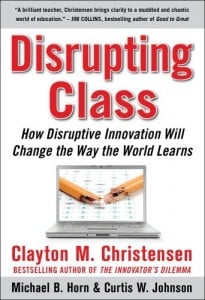 If you’re a teacher involved in the community of educators online, you may have heard of the book Disrupting Class by Clayton M. Christensen with Michael B. Horn and Curtis W. Johnson as co-authors. I decided to read the book after seeing Michael Horn’s keynote address at the VSS Annual Spring Conference last April.
If you’re a teacher involved in the community of educators online, you may have heard of the book Disrupting Class by Clayton M. Christensen with Michael B. Horn and Curtis W. Johnson as co-authors. I decided to read the book after seeing Michael Horn’s keynote address at the VSS Annual Spring Conference last April.
During his keynote, Michael introduced disruptive innovation theory and how it applied to current changes in education. I was intrigued by the combination of business theory and the field of education so, after being assured by Michael that the book wasn’t too US-centric for a Canadian teacher, I bought the book and have seen posts and articles about it online ever since.
It’s a good read and I would definitely recommend it to any educator. The book essentially looks at the reasons underlying schools’ current struggles to improve and then offers recommendations to solve the problems and end the struggles. The authors’ viewpoints are important:
“Our approach in researching and writing this book has been to stand outside the public education industry and put our innovation research on almost like a set of lenses to examine the industry’s problems from this different perspective.” (p. 6)
Their perspective hinges on the idea of disruptive innovation, which I’ll briefly try to describe (read the book, their description, with examples and graphs, is much better than I can do in a short paragraph). Disruptive innovation creates asymmetrical competition in any given market. A sustaining innovation, such as the public school system, is the industry leader providing certain services or products to consumers, whereas a disruptive innovation offers a product or service to non-consumers, thereby disrupting the market just enough to create change.
For example, the high school where I work is small (less than 300 students) and there is no French teacher, but, in the last two years, French 11 has been offered as a Distance Learning (DL) course online. The DL course is a disruptive innovation offering an alternative for students who previously had no way to take the course. Overall, the idea is that new and emerging technology in the field of education is a disruptive innovation which offers an alternate to a standard education in the public system. Since many students struggle in school, disruptive innovation within schools may be the answer needed to help more students succeed more of the time.
What I liked:
- the book is well written and easy to read. I liked the writing style.
- the detailed notes at the end of each chapter offer some great resources, articles, websites and readings to explore if you so desire
- the vignettes at the start of each chapter are a nice connecting thread throughout the book and offer a shift in writing style and perspective
- the book is full of excellent examples which help illustrate the authors’ arguments
- individual learning styles are key. Howard Gardner’s theory of multiple intelligences is discussed.
- the authors’ acknowledge the importance of using technology in transformative ways. There’s no point in using a SMART Board as one would use a flip chart (an example of an adaptive use of technology – one where the new technology is used in exactly the same way as old technology and the learning that occurs is essentially the same). Transformative uses of technology actually change the learning that occurs by creating the opportunity for new things to be learned that couldn’t have been learned without the use of the technology (for example, a collaborative blogging project involving two groups of grade five students, one group in Canada and one group in Austalia, could not occur without the use of blogs and the internet).
What could have been better:
- this is purely from a design point of view – I didn’t like the graphs in Chapter Two which helped to explain the theory of disruptive innovation. There are several 3D graphs, but it’s difficult to tell that they are 3D because they’re simple line graphs. Someone with a background in visual arts or design could easily add some tonal development to add form and depth, therefore making them look 3D.
Is this U.S.-based book applicable to educators outside of the U.S.?
Before I bought the book, I approached Michael to ask him this question. He was honest with his answer, admitting the book was based on research and statistics from the United States, but that the book was still applicable outside of the U.S. After reading the book I’ve noted many similiarities and differences between the situation in the States and Canada (specifically British Columbia), however, I definitely think that it’s worth the read no matter where one teaches.
Similiarities to education in British Columbia:
- more and more courses are being offered online. Many districts have a ‘virtual school’ with a variety of online options for students to choose from.
- the small, rural school where I work offers courses via Distance Learning that wouldn’t otherwise be offered
Differences to education in British Columbia:
- much less emphasis on standardized testing as compared to the U.S.
- Individual Education Planning, or IEPs, are designed for students who need drastic changes to be successful in the classroom
- in B.C., our curriculum is based not on textbooks, but on the Integrated Resources Packages created by B.C. teachers and local curriculum specialists
- many districts have Strong Start and other programs for early literacy interventions
- the politics are different
- teacher training is different with longer programs and rigorous certification requirements
Questions I still have:
- I’d like to know what the statistics are for British Columbia, Canada and other countries around the world. There are many interesting statistics in the book, for example, “by 2019, about 50 percent of high school courses will be delivered online” (p. 98) I’d like to know what the prediction is for Canada. And what about the projected stats for a country such as Finland which has an education system famous worldwide for it’s success?
- I don’t see how computer softare could be used to effectively and completely teach open-ended subjects such as art. I can see how computer software could be used by students to individualize their learning in a fact based subject like Math or Science, but what about Physical Education, or writing skills, or Dance?
Well, that ends my book report! Have you read the book? What did you think?

